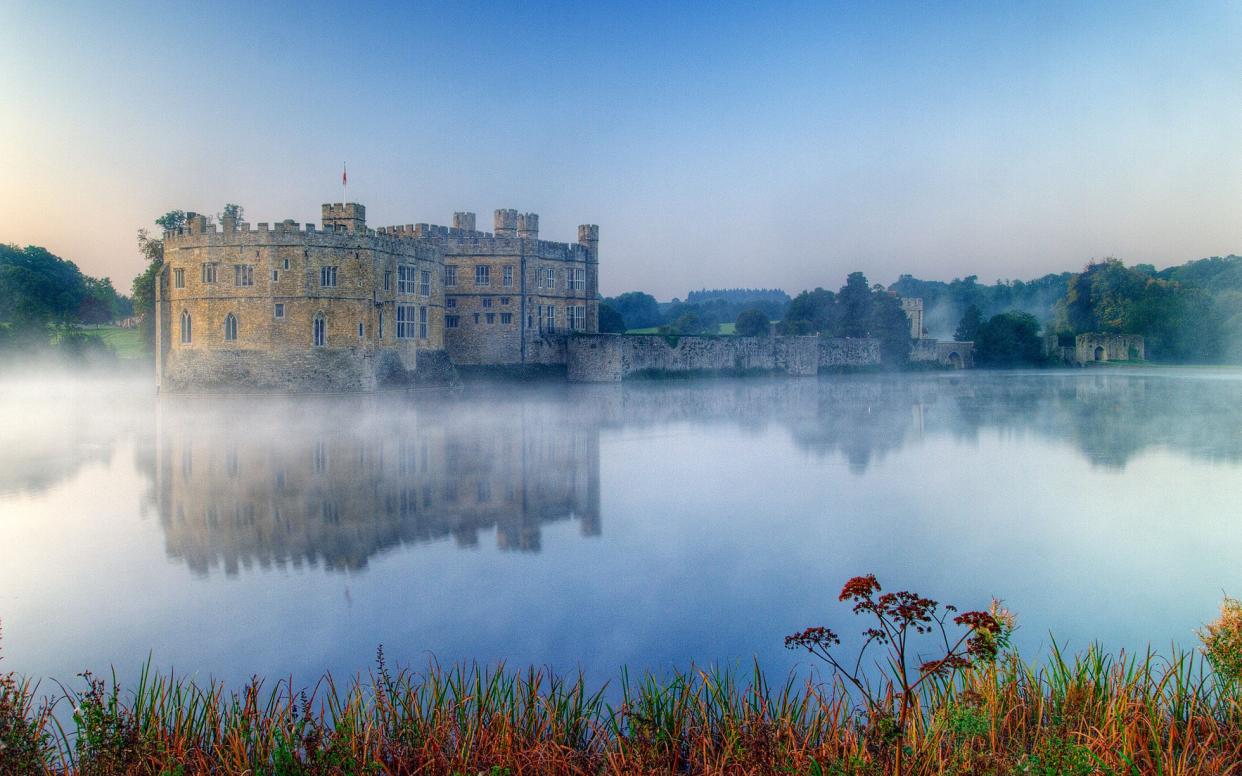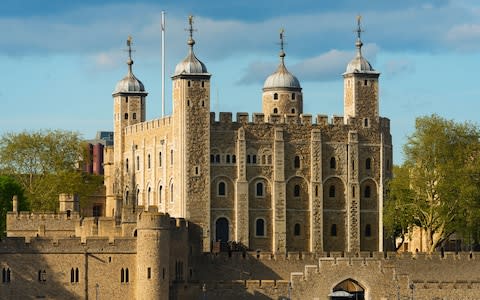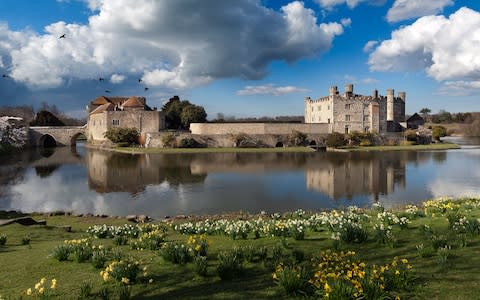An ode to the British castle – and the six best to visit this summer

Olive, Lady Baillie, the last chatelaine of Leeds Castle in Kent had little interest in the past, according to her biographer, “being far more concerned with the here and now”. Yet there she was, sitting on nine centuries of English history, encapsulated in one of the prettiest little moated castles you are ever likely to see.
I thought about this as I admired the unforgettable first view of her former home. The banks of the moat were swathed in daffodils, cherry blossoms and early magnolias, forming a collar of colour around the castle and its islands – one large, one small – connected by a stone bridge, all perched atop their reflections.
The castle has a fine gatehouse, with an ancient oak beam seat, polished by at least two centuries of use, whose function is mildly disputed – anything from a castle “naughty step” to a waiting place for travellers or servants – and a roof punctured with “murder holes” for the sploshing of boiling oil or sewage on unwanted guests.
You will find something similar, as venerable and as spectacular in its own way, in every county in Britain.
Ever since William the Conqueror commissioned our first true castle – in the form of the mighty Tower of London – we as a nation have taken this rugged, pugnacious architectural form to our hearts and adapted it to our own ends.

Perhaps it’s only when you are abroad that you realise quite how special they are.
In Ethiopia, the famed castles of Gondar, striking though they may be, are sadly empty of life, and while you can’t fault the Loire Valley’s spectacular chateaux, they rarely feel lived in or even furnished – especially not with original pieces.
But here on our doorstep, our castles often promise extraordinary exteriors, furniture and collections, paintings, dungeons and grounds – and sometimes even owners, too.
The Northumberlands, for example, still occupy Alnwick, while the Rutlands live at Belvoir. Some National Trust castles share ownership with their original families and Historic Houses, quite a few of them castles, are usually homes as well as landmarks. This gives many of our castles an extraordinary sense of continuity, of long occupation, of real domestic existence.

As for Leeds Castle, a charitable trust since Lady Baillie’s death in 1974, it celebrates a rather impressive 900th birthday this year and is in its 45th year as a public attraction.
On top of its 12th-century cellars, its exterior is largely Regency, rebuilt in the 1820s, while its interiors are glamorous Thirties to Sixties. It has a brilliantly bonkers collection of dog collars from the Seventies, a huge maze on top of a vividly-lit undersea-themed grotto from the Eighties, and is set to open new themed gardens and a castle playground this summer.
It’s a magnificently British muddle, which is just how a castle should be – and these are some of the UK’s finest.
One for the ladies
Once you’ve recovered from the view, imagine the six queens associated with the castle, including Catharine of Aragon and the lesser-known but fascinating Eleanor of Castile, who features in a series of podcasts narrated by Robert Bathurst for the anniversary.

Book a room for the night and have the castle to yourself after hours. Day visitors can take a ferry across the moat, tour the castle or watch one of the birds of prey shows. And don’t miss the newly-restored retable in the chapel. There’s an anniversary Carnival of History including a huge costumed procession on July 27 and 28.
Leeds Castle, Maidstone, Kent (01622 765400; leeds-castle.com). Tickets last all year and include the Carnival of History. Adults £25, children 4 to 15 £16.50.
Rugged rock of ages
Anyone who has been to wild Tintagel, allegedly the site of King Arthur’s conception in the fifth century, will recall steep steps down the cliff and then up on to Tintagel Island. This summer it reopens with an elegant bridge, outdoor exhibition and beach sculpture. There’s something very moving about the centuries-old worn walls, in a rugged Atlantic setting.
Tintagel Castle, North Cornwall (01840 770328; english-heritage.org.uk/visit/places/tintagel-castle). Adults £9.50, children 5 to 17 £5.70.
The oldest royal hub
Where else can you see a genuine royal stronghold in action? After years as the Queen’s favourite escape, Windsor Castle, the world’s oldest and largest occupied castle, is back in the limelight after last summer’s royal weddings and Meghan and Harry’s recent move to Frogmore Cottage on the Windsor Estate.

Major changes include the castle’s first café in Edward III’s gloriously vaulted undercroft, the restoration of Queen Mary’s dolls’ house and the opening up of the State Entrance to visitors, with views of the magnificent Long Walk. Of course don’t miss the Changing of the Guard, as well as the extraordinary art collection and St George’s Chapel.
Windsor Castle, Berkshire (030 3123 7304; rct.uk/visit/windsorcastle). Adults £22.50, under 17s £13.
Touches of the exotic
Powis Castle has a sense of the exotic and is remarkably striking, with battlemented red gritstone walls on an escarpment. Yet it also has terrace gardens tumbling down one side and its museum contains 300 objects from India, brought back (or plundered, depending on your view) by the Clive family, who married into the Herberts, the castle’s owners. Powis was built by a 13th-century Welsh prince as a stronghold against enemies to the north. Admire the two mighty drum towers, built in the next century, almost crushing the entrance.

Powis Castle, Welshpool, Powys (01938 551944; nationaltrust.org.uk/powis-castle-and-garden). Adults £15, children £7.50, with Gift Aid.
Over the sea to see Skye
“Hold fast!” is the motto of the Hebridean Clan MacLeod: bang on, as Dunvegan Castle, the oldest continuously occupied castle in Scotland, has been its home for 800 years. It’s stunningly beautiful, on the north-west coast of Skye, the 42,000-acre estate stretches to the Cuillins. See the castle interiors, fourth-century Fairy Flag and gardens. In summer take a boat trip to see seals (extra cost).
Dunvegan Castle, Skye (01470 521206; dunvegancastle.com). Adults £14, children 5 to 15 £9.
Join a Medieval fight club
It’s difficult to match a pedigree like Kenilworth’s. From a Norman keep in marshy land, it passed through the hands of King John, Simon de Montfort, John of Gaunt and Queen Elizabeth I’s favourite Robert Dudley, was wrecked in the Civil War and found fame in Sir Walter Scott’s novel Kenilworth. Sandstone walls contain the Great Tower, buildings by Dudley and Gaunt and Elizabethan-style gardens created a decade ago. See the Battle of Kenilworth recreation on Aug 25 and 26.
Kenilworth Castle, Warwickshire (01926 852078; english-heritage.org.uk/visit/places/kenilworth-castle). Adults £11.80, children 5 to 17 £7.10.


 Yahoo News
Yahoo News 
